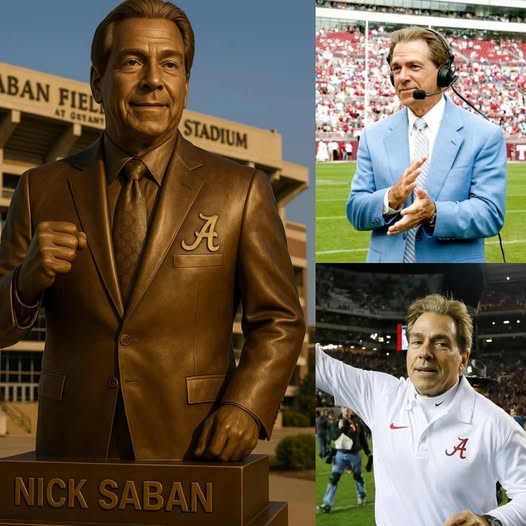When the University of Alabama’s Board of Trustees unanimously approved the construction of a $2.1 million statue of Nick Saban to stand outside Bryant-Denny Stadium—soon to be more colloquially referred to as “Saban Field”—it was not just a symbolic gesture. It was the enshrinement of a legacy, the immortalization of a man who did not merely coach a football team, but redefined an era of college football dominance.
The decision comes as no surprise to Crimson Tide faithful. Saban, who retired from coaching in January 2024 after 17 seasons in Tuscaloosa, leaves behind one of the most decorated legacies in the history of the sport. With seven national championships—six at Alabama—and a culture of relentless excellence, Saban became more than just a coach. He became a mythic figure. The approval to construct a statue isn’t just about honoring past glory; it’s about capturing an icon whose influence continues to shape Alabama football and college athletics at large.
The statue, set to be placed prominently outside Bryant-Denny Stadium, will be crafted in bronze, with lifelike precision and detail befitting the man whose steely gaze and calculated demeanor became emblematic of the “Process”—Saban’s famously disciplined, no-nonsense philosophy that turned Alabama into the standard-bearer for success. University officials have confirmed that the sculpture will feature Saban in his familiar sideline stance, headset on, arms folded or perhaps mid-gesture in a coaching command, encapsulating the very essence of the man millions came to revere on Saturdays.
The $2.1 million project will be funded entirely through private donations, according to the university. In fact, it was reported that several prominent Alabama boosters were among the first to pledge substantial contributions when the idea of the statue was floated. “It’s not just about what Coach Saban did on the field,” said one anonymous donor. “It’s what he did for the university, the state, and college football. There’s no price too high for honoring that legacy.”
Saban’s tenure at Alabama transformed the program into a dynasty. From the moment he arrived in 2007, the shift in culture was immediate. Recruiting became more intense, player development more rigorous, and expectations exponentially higher. Under Saban’s leadership, the Tide went on to win national titles in 2009, 2011, 2012, 2015, 2017, and 2020. His seventh overall championship, earned during his stint with LSU in 2003, tied him with Paul “Bear” Bryant—another Alabama coaching titan—but many argue Saban’s resume eclipses even Bryant’s, especially when considering the modern era’s competitive parity and media scrutiny.
The statue’s location at Bryant-Denny Stadium is no coincidence. Earlier this year, the field was officially renamed “Saban Field” in honor of the coach, further intertwining his identity with the very foundation of Alabama football. The stadium, a hallowed cathedral of college football, will now house a permanent physical tribute, reminding all who enter that this is the house Saban built.
To understand why this moment carries such profound weight, one must grasp the depth of Saban’s impact. Before his arrival, Alabama had endured years of inconsistency, coaching turnovers, and NCAA infractions. The mystique of the Crimson Tide had dulled. But Saban brought clarity. He restored discipline. More than anything, he restored belief. Every title won, every five-star recruit signed, every moment of resilience and triumph—they all trace back to the culture he instilled.
Perhaps even more significant than championships are the lives he influenced. Saban’s emphasis on academics, personal growth, and accountability helped countless young men find direction and purpose. Many former players speak not only of the rings they earned but of the values Saban instilled—resilience, humility, preparation, and the will to never settle for less than one’s best. His famed “24-hour rule”—celebrate a win or mourn a loss, then get back to work—epitomized the unrelenting pursuit of excellence that came to define the Alabama program under his leadership.
Former players, now stars in the NFL or successful in other walks of life, often return to Tuscaloosa to visit “Coach.” To them, he’s more than just a football mind—he’s a mentor, a father figure, a builder of men. That’s what makes the statue more than just a monument; it’s a mirror of influence stretching far beyond wins and losses.
The decision to commission the statue wasn’t made lightly. There were discussions about design, placement, and how best to capture the full magnitude of Saban’s contribution. The artist chosen for the project is expected to be revealed in the coming months, and the statue will likely be unveiled in a grand ceremony coinciding with a major home game during the 2026 season. That ceremony, university insiders say, could rival the scale of a national championship celebration.
Students, alumni, and fans have embraced the idea with palpable excitement. Already, social media has buzzed with mockups, tributes, and suggestions for what the statue should look like. Some even propose incorporating elements like a pedestal engraved with famous Saban quotes or a nearby plaque detailing his coaching record, championships, and notable accolades. Others suggest creating a small plaza around the statue—“Saban Square,” as it’s being nicknamed online—where fans can gather before games, take photos, and reflect on the era that was.
The statue also serves as a historical anchor. Decades from now, when new generations of fans and players walk past it, they’ll be reminded of the gold standard that Saban set. Just as children once asked their parents about Bear Bryant, future Alabama fans will ask about Nick Saban, and the stories passed down will be etched not only in words but in bronze. In an age where college athletics are constantly evolving—with NIL, transfer portals, and playoff expansions—Saban’s legacy stands as a constant: proof that greatness is possible through discipline, vision, and a relentless commitment to doing things the right way.
Though no longer roaming the sidelines, Saban’s influence remains deeply embedded in the program. He now serves as a special advisor to the university’s athletic department, and his fingerprints are all over the coaching staff, many of whom either played for him or coached under him. The current head coach, widely believed to be handpicked by Saban himself, has vowed to maintain the program’s standards while building upon the foundation laid before him.
Beyond Tuscaloosa, the statue also sends a message to the broader world of college football. It is a declaration that Saban’s influence transcends wins; it altered the trajectory of an entire sport. From revolutionizing recruiting processes to changing how programs structure operations around “the Process,” his methods have been studied, mimicked, and admired nationwide. This is not merely the erection of a statue—it is the official recognition that the sport itself will never be the same because of one man.
In many ways, the statue completes a circle. When Saban first arrived, skeptics questioned whether he could resurrect a once-proud program. Now, nearly two decades later, he leaves it as the preeminent dynasty of modern college football. A statue will stand where doubt once lived. Where uncertainty once lingered, bronze permanence will now testify to the power of vision, leadership, and unyielding pursuit of greatness.
For Alabama fans, the statue is not just a structure—it’s a pilgrimage site, a place of reverence. For players, it’s a reminder of what’s possible when you buy into something bigger than yourself. For the sport, it is a towering reminder that legends may leave the sidelines, but their presence never fades.
Nick Saban may have retired from coaching, but in Tuscaloosa, on the field that now bears his name, just outside the stadium where his teams authored countless moments of glory, his presence will loom eternal. Forever cast in bronze, the greatest coach of the modern era will watch over the program he built into a dynasty, inspiring generations to come.



